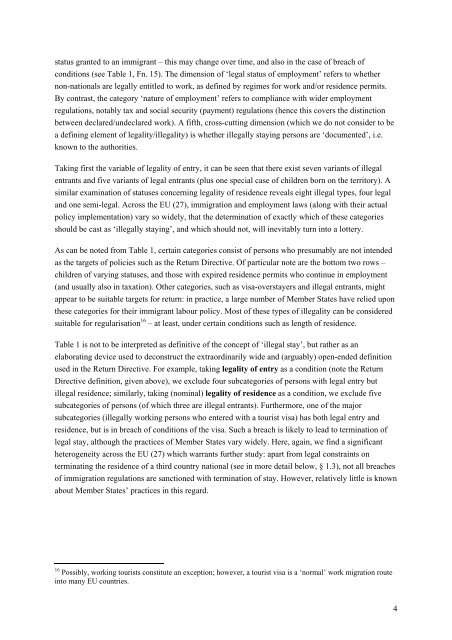REGINE Regularisations in Europe Final Report - European ...
REGINE Regularisations in Europe Final Report - European ...
REGINE Regularisations in Europe Final Report - European ...
Create successful ePaper yourself
Turn your PDF publications into a flip-book with our unique Google optimized e-Paper software.
status granted to an immigrant – this may change over time, and also <strong>in</strong> the case of breach of<br />
conditions (see Table 1, Fn. 15). The dimension of ‘legal status of employment’ refers to whether<br />
non-nationals are legally entitled to work, as def<strong>in</strong>ed by regimes for work and/or residence permits.<br />
By contrast, the category ‘nature of employment’ refers to compliance with wider employment<br />
regulations, notably tax and social security (payment) regulations (hence this covers the dist<strong>in</strong>ction<br />
between declared/undeclared work). A fifth, cross-cutt<strong>in</strong>g dimension (which we do not consider to be<br />
a def<strong>in</strong><strong>in</strong>g element of legality/illegality) is whether illegally stay<strong>in</strong>g persons are ‘documented’, i.e.<br />
known to the authorities.<br />
Tak<strong>in</strong>g first the variable of legality of entry, it can be seen that there exist seven variants of illegal<br />
entrants and five variants of legal entrants (plus one special case of children born on the territory). A<br />
similar exam<strong>in</strong>ation of statuses concern<strong>in</strong>g legality of residence reveals eight illegal types, four legal<br />
and one semi-legal. Across the EU (27), immigration and employment laws (along with their actual<br />
policy implementation) vary so widely, that the determ<strong>in</strong>ation of exactly which of these categories<br />
should be cast as ‘illegally stay<strong>in</strong>g’, and which should not, will <strong>in</strong>evitably turn <strong>in</strong>to a lottery.<br />
As can be noted from Table 1, certa<strong>in</strong> categories consist of persons who presumably are not <strong>in</strong>tended<br />
as the targets of policies such as the Return Directive. Of particular note are the bottom two rows –<br />
children of vary<strong>in</strong>g statuses, and those with expired residence permits who cont<strong>in</strong>ue <strong>in</strong> employment<br />
(and usually also <strong>in</strong> taxation). Other categories, such as visa-overstayers and illegal entrants, might<br />
appear to be suitable targets for return: <strong>in</strong> practice, a large number of Member States have relied upon<br />
these categories for their immigrant labour policy. Most of these types of illegality can be considered<br />
suitable for regularisation 16 – at least, under certa<strong>in</strong> conditions such as length of residence.<br />
Table 1 is not to be <strong>in</strong>terpreted as def<strong>in</strong>itive of the concept of ‘illegal stay’, but rather as an<br />
elaborat<strong>in</strong>g device used to deconstruct the extraord<strong>in</strong>arily wide and (arguably) open-ended def<strong>in</strong>ition<br />
used <strong>in</strong> the Return Directive. For example, tak<strong>in</strong>g legality of entry as a condition (note the Return<br />
Directive def<strong>in</strong>ition, given above), we exclude four subcategories of persons with legal entry but<br />
illegal residence; similarly, tak<strong>in</strong>g (nom<strong>in</strong>al) legality of residence as a condition, we exclude five<br />
subcategories of persons (of which three are illegal entrants). Furthermore, one of the major<br />
subcategories (illegally work<strong>in</strong>g persons who entered with a tourist visa) has both legal entry and<br />
residence, but is <strong>in</strong> breach of conditions of the visa. Such a breach is likely to lead to term<strong>in</strong>ation of<br />
legal stay, although the practices of Member States vary widely. Here, aga<strong>in</strong>, we f<strong>in</strong>d a significant<br />
heterogeneity across the EU (27) which warrants further study: apart from legal constra<strong>in</strong>ts on<br />
term<strong>in</strong>at<strong>in</strong>g the residence of a third country national (see <strong>in</strong> more detail below, § 1.3), not all breaches<br />
of immigration regulations are sanctioned with term<strong>in</strong>ation of stay. However, relatively little is known<br />
about Member States’ practices <strong>in</strong> this regard.<br />
16 Possibly, work<strong>in</strong>g tourists constitute an exception; however, a tourist visa is a ‘normal’ work migration route<br />
<strong>in</strong>to many EU countries.<br />
4
















